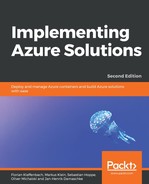Book Description
Get up and running with Azure services and learn how to implement them in your organization
Key Features
- Deploy Azure Services in a controlled and preconfigured environment
- Discover best practices and techniques for implementing Azure Solutions
- Build and deploy an app using Azure App Services
Book Description
Microsoft Azure offers numerous solutions that can shape the future of any business. However, the major challenge that architects and administrators face lies in implementing these solutions.
Implementing Azure Solutions helps you overcome this challenge by enabling you to implement Azure Solutions effectively. The book begins by guiding you in choosing the backend structure for your solutions. You will then work with the Azure toolkit and learn how to use Azure Managed Apps to share your solutions with the Azure service catalog. The book then focuses on various implementation techniques and best practices such as implementing Azure Cloud Services by configuring, deploying, and managing cloud services. As you progress through the chapters, you'll learn how to work with Azure-managed Kubernetes and Azure Container Services.
By the end of the book, you will be able to build robust cloud solutions on Azure.
What you will learn
- Create and manage a Kubernetes cluster in Azure Kubernetes Service (AKS)
- Implement site-to-site VPN and ExpressRoute connections in your environment
- Explore the best practices in building and deploying app services
- Use Telemetry to monitor your Azure Solutions
- Design an Azure IoT solution and learn how to operate in different scenarios
- Implement a Hybrid Azure Design using Azure Stack
Who this book is for
If you're an IT architect, IT professional, or DevOps engineer who plans to implement Azure Solutions for your organization, this book is for you.
